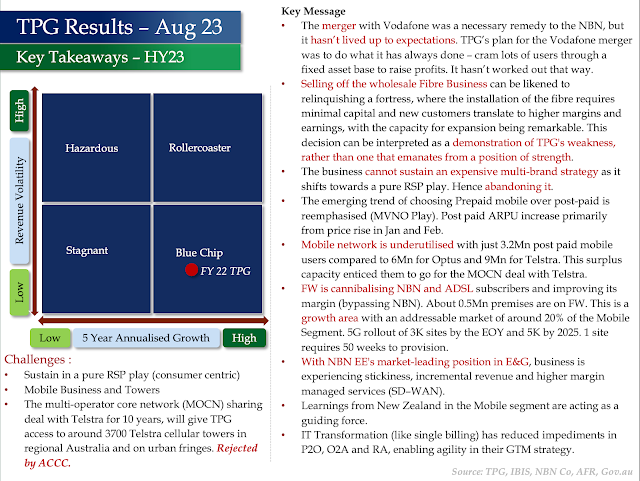From Four to Six Pillars: The Evolution of the Australian Telecom Industry
The Rise of Aussie Broadband:
The Australian telecommunications landscape has witnessed a significant transformation in recent years, shifting from a traditional four-pillar model dominated by Telstra, Optus, TPG, and the NBN to a six-pillar model that now includes Vocus and Aussie Broadband. This evolution has been driven by a confluence of factors, including regulatory changes, evolving consumer demands, technological advancements, and strategic diversification.
A "pillar" refers to any telecommunications operator with a revenue of $1Bn or more.
A New Era of Competition
Aussie Broadband, with its rapid growth and strategic acquisitions, has emerged as a key player in this evolving market. With revenue at ~$1Bn, the company is poised to solidify its position as the sixth pillar of the Australian telecommunications industry. (PE TTM - 35.7, PB - 1.7)
Key Factors Driving the Transition
Regulatory Framework:
The ACCC's role in promoting fair competition and open access to the NBN has created opportunities for new entrants.
Changing Consumer Needs: Australian consumers are increasingly demanding reliable, high-speed connectivity, personalised services, and cost-effective solutions.
Technological Advancements: The rollout of 5G, cloud-based and AI-enabled services, and other innovations have lowered barriers to entry.
Diversification and Consolidation: Providers are expanding their service offerings and gaining economies of scale through mergers and acquisitions.
Aussie Broadband's Growth Strategy
Aussie Broadband has been actively pursuing a growth strategy that involves both organic expansion and strategic acquisitions. The company's recent acquisition of Symbio, a leading provider of NBN services, is a testament to its ambition to consolidate its market position.
Superloop: A Strategic Target: One of Aussie Broadband's most intriguing prospects is its potential acquisition of Superloop. With a nearly ~12% stake in Superloop, Aussie Broadband is well-positioned to capitalise on opportunities in the market. Analysts predict that such an acquisition could significantly enhance Aussie Broadband's capabilities and further solidify its position as a major player in the Australian telecommunications industry.
Conclusion: The Australian telecommunications industry is undergoing a period of dynamic transformation, characterised by increased competition, technological innovation, and strategic consolidation. Aussie Broadband's emergence as a significant player in this evolving market is a testament to its ability to adapt to changing market conditions and capitalise on new opportunities. As the company continues to grow and expand its reach, it is poised to play a pivotal role in shaping the future of the Australian telecommunications landscape.
Src: Excerpt from my book on NBN, AFR, WSJ
#australia #telecom #future #strategy #M&A








 \
\










